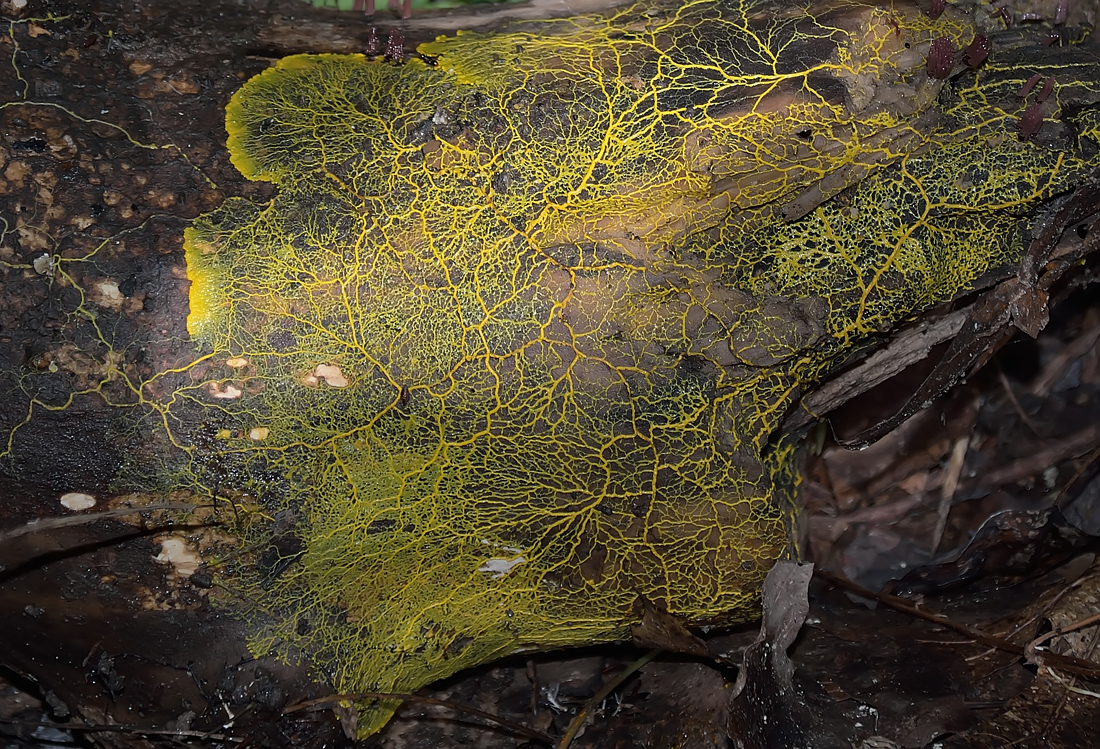
Hannah Gillespie | October 11, 2019 | 2 Comments

A chocolate tube slime mold in the Stemonitus genus emerges from a tree at Shenandoah Mountain. Slime mold is at least 600 million years old, which means it could be one of the first organisms formed by independent cells joining together. Photo by Jason Hollinger
This remarkable organism is broadly known as slime mold, though there are many kinds.
Researchers from the Smokies All Taxa Biodiversity Inventory recorded at least 230 species of myxomycetes — a type of slime mold with one cell surrounded by membranes and a nucleus — within Great Smoky Mountains National Park. With about 1,000 known myxomycetes species worldwide, the Smokies hold nearly a quarter of the known global population, according to Steve Stephenson, a professor of biological sciences at the University of Arkansas.
Those hunting slime mold in Appalachia will want to embark during the fruiting season between late May and early October, after a period of rainy weather, and search among decaying logs on the forest floor.
Slime mold comes in various colors and shapes, from the reddish-brown Stemonitis axifera, which is distinguished by its tall stalks, to the vivid yellow of the Fuligo septica, also known as dog vomit slime mold due to its bile-appearance, which can be as large as a dinner plate. Fuligo septica is found in forests as well as among mulch beds in urban areas, but it poses no harm to grass or plants, so control is not necessary.
As cells, slime molds live in the soil and feed on bacteria, releasing nutrients that plants need in the process.
“Slime molds are key players in nutrient cycling, which is incredibly important to how the Earth functions,” says Stephenson.
Enemies of slime mold include beetles and slugs, to name a few. Since slime mold is not toxic, anything can eat it. Although some species exist in Arctic regions, most slime mold does not fare well in cold climates.
When food is scarce, the single-celled organism will emit chemical signals to attract other slime molds and form a bigger mass. This chemical process, referred to as the plasmodial life stage, also prevents competition between individuals and aids in communication. However, this process does make the slime mold sensitive to airborne chemicals.
Once joined together, these formerly independent cells cooperate and move in unison as a gelatinous, multicellular structure that can be up to several meters in diameter and has the ability to travel faster and farther than before.
In this state, the slime mold transitions into another significant part of its lifecycle and produces a fruiting body, which can take on various shapes and forms, typically a millimeter or two high. One type looks similar to a small globe atop a delicate stalk, although stalks are not always necessary. The goal of this state is to release spores, which the wind or passing animals can transport so the slime mold can begin the life cycle again.
Slime mold, like some protists, possesses both plant and animal characteristics. But slime mold also has exceptional intelligence. In an interview with Princeton University, the late John Tyler Bonner, a professor emeritus of biology and a top slime mold expert, described them as “no more than a bag of amoeba encased in a thin slime sheath, yet they manage to have various behaviours that are equal to those of animals who possess muscles and nerves with ganglia – that is, simple brains.”
When studied under a microscope, the complexities of slime mold are apparent. Not only does slime mold appear to branch out through vein-like structures, but its movement is quite unique.

Once the water-soaked surface of this rotten log dries, Physarum polycephalum slime mold will no longer be able to travel. The slime will then change form and become stationary. This slime mat is about the size of a dinner plate and was found at Patapsco Valley State Park in Howard County, Md. Photo by Richard Orr
“It’s similar to what happens in our muscles when they contract,” Juan Carlos del Álamo, a University of California San Diego professor of mechanical and aerospace engineering, told KQED Science.
The pulsating slime mold can reach speeds of up to 1.35 millimeters per second, making it the fastest microorganism recorded.
A 2012 study revealed that slime mold can solve mazes and appears to learn new things about its environment. When food is placed at the end, slime mold locates the food by exploring every part of the maze. The slime mold will find the shortest path to the food and retract all paths that don’t lead to these points, leaving behind a trail of slime that chemically signals a dead end, according to The Well, the news platform of the University of Chicago’s Marine Biological Laboratory.
Astoundingly, slime mold fairly accurately mapped a portion of the Japanese rail system, according to a January 2010 paper published in Science. In the experiment, researchers from Japan and England placed oat flakes in a pattern similar to the way outlying cities are distributed around Tokyo and allowed the slime mold to roam. The research team believes that a new model of the rail system based on the slime mold’s behavior may be more efficient and adaptable.

Become a part of the Appalachian Voices’ network of advocates — sign up for action alerts and the our monthly e-newsletter The Advocate today!
A January 2008 study demonstrates that these amazing organisms can learn to memorize and anticipate changes in their environment that keep happening. In the experiment, scientists lowered the temperature and humidity around a plate with slime mold for 10-minute intervals. Each time, the slime mold would slow down its movement to conserve energy.
After three instances of cold conditions, the scientists stopped manipulating the temperature and observed the slime mold starting to slow down, in anticipation of the change, but returning to normal when conditions remained stable for a while. As soon as the cold conditions returned, they resumed the behavior and correctly recalled the appropriate timing of the intervals. The researchers note that for a single cell to demonstrate such a learning ability demonstrates a “primitive version of brain function.”
Even more incredible, a 2016 experiment showed that not only can slime molds get used to a chemical they don’t like over time, they can share what they have learned with other slime molds by fusing with them.
This is a form of learning called “habituation,” which the researchers tested by challenging the slime mold with quinine and caffeine, both harmless, yet bitter-tasting chemicals. The only way for the organism to reach its food was to cross a bridge covered in the bitter substances, which the slime mold was initially reluctant about. This bridge crossing took the slime mold more than triple the amount of time it took a control group without a chemically treated bridge. By day six, the slime mold cut its crossing time in half.
In a separate experiment conducted by these researchers, they introduced a slime mold that had been exposed to salt and a “naive” slime mold that had not. The molds formed together and demonstrated zero apprehension about crossing a salted bridge. It appears that the habituated slime mold had educated the naive one through a vein after two to three hours of fusion, although it is unclear what is going on inside the channel.
What is clear is that there is something biochemical going on within these brainless, gelatinous slime molds that scientists have yet to figure out. Already, scientists are excited about harnessing slime mold’s abilities in unique ways, including creating adaptable, wireless networks for natural disasters, testing slime mold’s antibiotic properties in clinical trials against cancer cells, converting plasmodial slime mold into biofuel and more.
Slime mold’s abilities “might be a chance to reconsider what intelligence is,” biophysicist and slime mold researcher Toshiyuki Nakagaki told Discover Magazine.
So while that nuclear-yellow blob encasing a decaying trailside tree limb may look like dog vomit, a closer look might reveal primordial intelligence in action.
Like this content? Subscribe to The Voice email digests
Great story guys!!
Now I need to read more!
It is a great article. But how can these scientist be aware of the capabilities of slime molds and then think “hey, let’s try using this stuff for fuel!” Can’t we find ways to live our lives that don’t require needlessly exploiting other life forms?